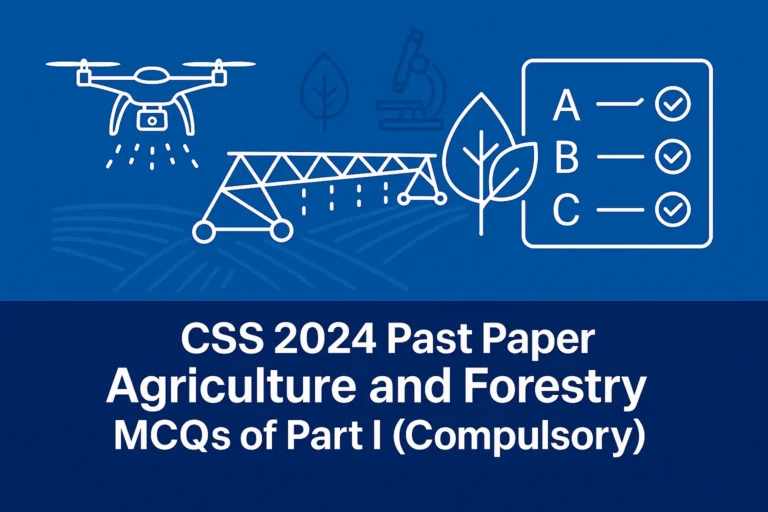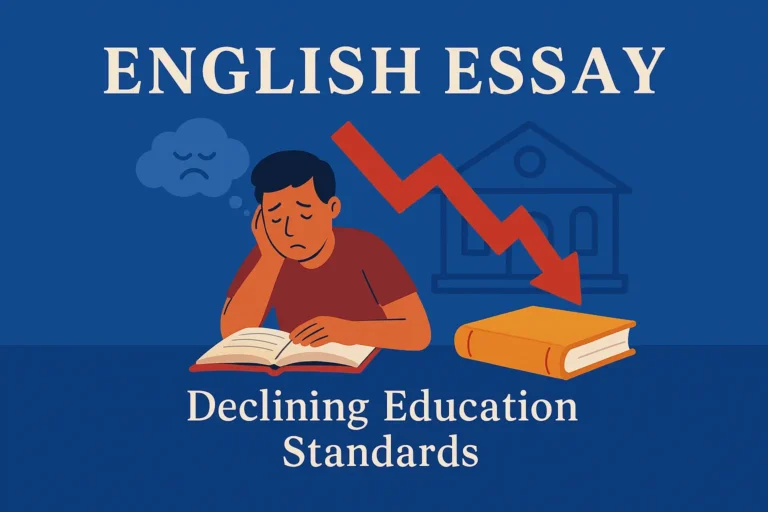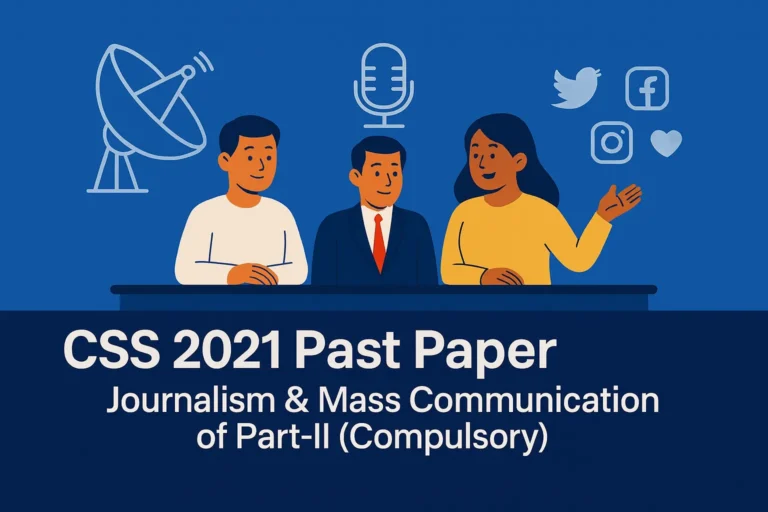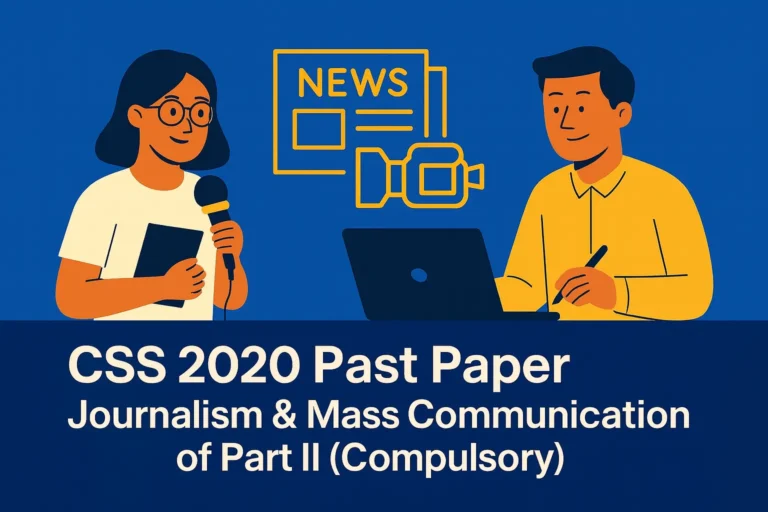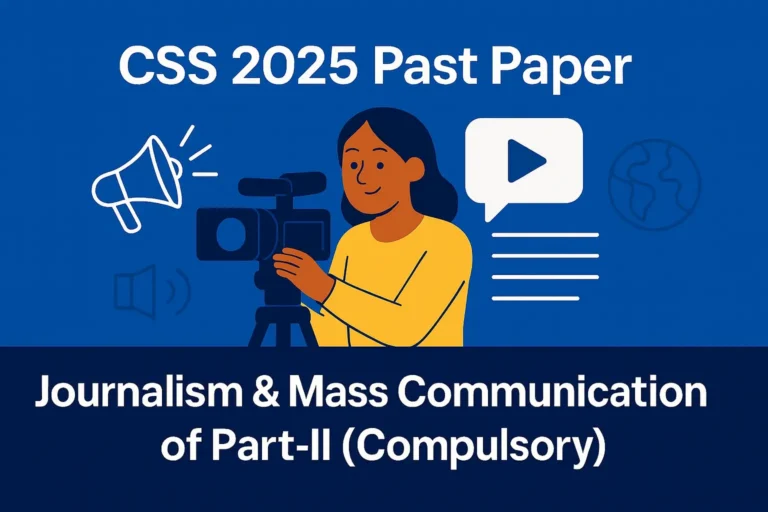CSS 2019 Solved Past Paper – Journalism & Mass Communication Part-II (Compulsory)
Below is the solution to PART-II (COMPULSORY) of the CSS 2019 Journalism & Mass Communication Paper.
Question 2
Discuss Marshal McLuhan’s theory of media determinism in the light of powerful media effects revisited paradigm.
Introduction
Marshal McLuhan was a Canadian media theorist who gave the famous concept “The medium is the message”. His theory of media determinism explains how different types of media affect the way people think, feel, and behave. He believed media doesn’t just deliver messages—it shapes human experience and society. In the light of powerful media effects revisited paradigm, McLuhan’s theory still holds importance today.
What is Media Determinism?
Media determinism means that media technology shapes and controls human culture and society. McLuhan believed that every new medium changes how we see the world. For example:
- The invention of print media changed oral traditions.
- The rise of electronic media changed the speed of communication.
He divided history into four major ages:
| Age | Medium | Effect on Society |
| Tribal Age | Oral communication | People lived in groups, strong memory |
| Literate Age | Writing | Logical thinking increased |
| Print Age | Printing press | Mass production of ideas, nationalism |
| Electronic Age | Television, radio, etc. | Instant communication, global village |
“The Medium is the Message”
This is McLuhan’s most famous quote. He means that the way we receive information is more important than the content itself. For example:
- A TV changes our emotions and thinking more than the actual news it shows.
- A smartphone connects people, but also changes habits like reading, sleeping, and focus.
So, the medium (tool) has more power than the actual message.
Powerful Media Effects Revisited Paradigm
Earlier, media effects were seen as strong and direct (like bullet theory). Then scholars believed media had limited effects. But now, with the rise of digital media, the powerful effects paradigm is being revisited, which agrees again that:
- Media can strongly influence thoughts and behavior.
- Agenda-setting, framing, and priming are real effects.
- Media creates perception of reality, especially among youth.
McLuhan’s ideas match this modern thinking. He already warned that media is not just a tool; it alters our environment.
Examples in Today’s World
- Social Media Platforms like Instagram or TikTok are not just entertainment—they have changed how people communicate and define beauty or success.
- 24/7 News Channels create stress and urgency by showing breaking news non-stop.
- The internet and smartphones have created a digital global village, exactly like McLuhan predicted.
Criticism on McLuhan’s Theory
Some critics say McLuhan was:
- Too focused on technology and ignored other social factors like politics or economy.
- His theory is too philosophical, not scientific or testable.
- He ignored the content of media completely.
But still, many of his ideas became true in today’s digital age.
Conclusion
Marshal McLuhan’s media determinism theory is still relevant. It shows how media shapes culture, behavior, and even brain activity. The modern revisiting of powerful media effects proves McLuhan was ahead of his time. In a world full of smartphones, social media, and global news, “The medium is the message” is more real than ever. Media doesn’t just reflect reality—it creates it.
Question 3
What are normative theories of the press? Discuss criticism on these theories and also discuss their implication in Pakistani society.
Introduction
Normative theories of the press are rules or ideas that explain how media should operate in a society. These theories were introduced by Fred Siebert, Theodore Peterson, and Wilbur Schramm in their book “Four Theories of the Press” (1956). These theories are based on different political and social systems.
They don’t tell us how media works—but how it ought to work, depending on the values of the country.
Types of Normative Theories
a) Authoritarian Theory
- Media is controlled by the government.
- No freedom of press.
- Journalists need permission to publish.
- Example: Nazi Germany, North Korea.
b) Libertarian Theory
- Full freedom of press.
- People can publish anything.
- Government doesn’t control the media.
- Example: U.S. and other Western democracies.
c) Social Responsibility Theory
- Media is free but must be responsible.
- Journalists should provide truth, fairness, and balance.
- Media must serve public interest.
- Example: Modern democracies, like UK, Canada.
d) Soviet-Communist Theory
- Media works as a tool of the ruling Communist Party.
- Purpose is to spread ideology.
- No private media allowed.
- Example: Soviet Union (historical), China (partly today).
Criticism on Normative Theories
- The four theories are based on Cold War thinking—Western vs. Eastern models.
- They are too simplified and don’t explain mixed models like Pakistan or India.
- Outdated in the digital era where social media and citizen journalism exist.
- The theories ignore global influences and treat every country as isolated.
- They focus more on ideals than real media practices.
Implication in Pakistani Society
Pakistan has a mixed media system, so we can’t apply only one theory. Different elements of each theory can be seen:
a) Authoritarian Elements
- PEMRA controls electronic media.
- Journalists face pressures and censorship.
- Government sometimes blocks channels or news.
b) Libertarian Elements
- Many private TV channels and newspapers exist.
- People use social media freely (to some extent).
- Talk shows criticize politicians and policies.
c) Social Responsibility
- Some media outlets try to promote public awareness and social issues.
- Campaigns on education, health, etc. are run sometimes.
d) Challenges
- Media often focuses on breaking news and ratings instead of facts.
- Fake news and sensationalism are common.
- Lack of media literacy in public.
Conclusion
Normative theories help us understand how media should behave under different political systems. But in today’s complex world, especially in a country like Pakistan, no single theory fully applies. Media freedom is there, but so are government controls. There’s a need for balance between freedom and responsibility. Pakistani media must grow towards social responsibility, ensuring truth, ethics, and service to the public.
Question 4
How mass media and technology contribute in globalization? Do you think that we are living in a global village? Justify your answer with logical arguments.
Introduction
Mass media and technology play a central role in globalization. They connect people across the world and help share ideas, culture, news, and knowledge instantly. Marshal McLuhan gave the term “Global Village” which means the world has become like a small village where everyone is connected through media.
Role of Mass Media in Globalization
a) Spreads Information Quickly
Media spreads news and events across borders in seconds. A war, disaster, or event in one country becomes global news.
b) Promotes Culture Sharing
Through movies, music, and drama, media spreads cultures. Now people in Pakistan watch Korean dramas, Indian films, and English shows.
c) Creates Global Awareness
Media informs us about global issues like climate change, terrorism, pandemics, and human rights. It builds awareness and unity.
d) Advertising and Brands
Global companies use media to promote their products everywhere. McDonald’s, Coca-Cola, and Samsung are known worldwide due to media.
Role of Technology in Globalization
a) Internet and Social Media
Apps like WhatsApp, Facebook, and X (Twitter) help people talk and share ideas worldwide. A person in Pakistan can talk to someone in America within seconds.
b) Mobile Phones and Smart Devices
Smartphones give access to the world in our hands. We can shop, study, or work from any place.
c) Transport and Satellite Tech
Fast transport and satellite communication make it easier to travel and share media globally.
d) E-commerce and Online Business
Technology has changed trade. Now people can buy or sell goods online, even across borders (like Amazon, Daraz, AliExpress).
Are We Living in a Global Village?
Yes, we are living in a global village. Some logical reasons are:
a) Instant Communication
A person can live-stream from anywhere. For example, news from Gaza is watched in real-time in Pakistan.
b) Same Trends Everywhere
Social media challenges, memes, songs go viral globally. People in different countries follow the same trends.
c) Shared Problems and Solutions
We face global problems like COVID-19 together. Vaccines and health guidelines were shared globally.
d) Online Learning and Work
People take online courses from foreign universities and attend meetings on Zoom with people in other countries.
Some Limitations
- Digital Divide: Poor people or remote areas still lack internet or media access.
- Cultural Loss: Local cultures are getting weaker due to foreign influence.
- Fake News & Misinformation: Global spread of false info is also a danger.
Conclusion
Mass media and technology are the main engines of globalization. They bring people, cultures, and economies closer. Despite some challenges, it is true that we are now living in a global village, just as Marshal McLuhan predicted. Today, distance is no longer a barrier, and the world is connected like never before.
Question 5
Critically discuss the impact of commercialism on selection and presentation of news reports in perspective of Pakistani mainstream news channels.
Introduction
In Pakistan, mainstream news channels have become highly commercial. Their main goal is no longer to just inform the public, but also to earn money through ads and ratings (TRPs). This trend of commercialism has changed the way news is selected and presented. News is often chosen not for its importance but for how many viewers it can attract.
What is Commercialism in Media?
Commercialism means the influence of business and profit-making in media content. In this model, news is treated like a product, and viewers are treated like customers. The more viewers, the more advertisers will pay to run their ads on that channel.
How Commercialism Affects News Selection?
a) Focus on Sensationalism
Channels choose news that creates shock or strong emotions (like crime, scandals, or celebrity gossip), even if it’s not very important.
b) Neglect of Public Interest Stories
Important issues like education, healthcare, poverty, and climate change are often ignored because they don’t bring high ratings.
c) Breaking News Culture
Channels run after “breaking” stories, often without full facts, just to be first, not accurate.
d) Preference for Political Drama
Channels often show political fights and controversial statements to increase viewership. Real policy discussions are rare.
How Commercialism Affects News Presentation?
a) Dramatic Presentation Style
News is presented like entertainment, with background music, loud graphics, and emotional anchors.
b) Anchor-Driven Shows
Popular anchors are given too much power. They shape opinions rather than just giving facts.
c) Biased Coverage
Sometimes news is shaped to please advertisers or political sponsors, which harms credibility.
d) Repetition of Same Stories
Popular stories are shown again and again, while other news is ignored completely.
Examples from Pakistani Media
- Coverage of political talk shows like “Capital Talk” or “Off the Record” often focuses on political fights, not solutions.
- Major social issues like Tharparkar’s drought or education crisis in Balochistan get very little airtime.
- During elections or national crises, some channels take sides instead of staying neutral.
Impact on Society
- Public is misinformed or under-informed about real issues.
- It increases polarization in society because people only see one side of the story.
- Trust in media is going down.
- Journalism becomes a business, not a service.
Suggestions to Improve
- PEMRA should enforce rules to ensure balanced reporting.
- Media houses should train journalists on ethical journalism.
- Viewers should be media literate and demand quality news, not drama.
- Encourage public interest journalism through funding and support.
Conclusion
Commercialism has deeply affected how Pakistani news channels select and present news. The focus has shifted from serving the public to chasing ratings and profits. This trend is dangerous for democracy and social awareness. If media continues this path, public trust will keep falling. It’s time for both journalists and viewers to realize the value of truthful and responsible journalism.
Question 6
Do you think that PR is a tool of governance? Why is it necessary for a public relations department to serve as early warning system?
Introduction
Yes, Public Relations (PR) is an important tool of governance. It helps the government communicate with the public, manage its image, explain its policies, and respond to public concerns. PR is not just about promotion—it also acts as a bridge between the government and the people. An effective PR department also works like an early warning system by informing leaders about public mood, media trends, and possible crises.
How PR Works as a Tool of Governance?
a) Spreads Government Policies
PR helps in explaining government plans and laws to the public through press releases, media briefings, and social media.
b) Builds Trust
When PR is done properly, it builds a good image of the government. People are more likely to support policies they understand.
c) Handles Crisis Communication
During problems like floods, political crises, or economic issues, PR helps calm the public by providing correct and timely information.
d) Manages Media Relations
PR officers maintain contact with journalists and media houses to ensure fair coverage of government actions.
e) Improves Public Engagement
By taking public feedback and responding, PR makes citizens feel heard and involved in governance.
Why PR Department Should Work as Early Warning System?
An early warning system means spotting problems before they grow big. PR departments can help in this by:
a) Monitoring Public Opinion
PR teams watch what people are saying on social media, in the press, or in public protests. This helps the government act early.
b) Detecting Negative Trends
If people are angry about inflation, unemployment, or bad services, PR can inform the leadership to take steps before it turns into a crisis.
c) Managing Rumors and Misinformation
Fake news spreads fast. PR can detect it early and stop it by providing factual updates.
d) Feedback Loop
PR collects complaints, suggestions, and reactions from the public and gives that data to policymakers to improve decisions.
e) Protects Government Reputation
By acting early, PR can prevent damage to the government’s image. For example, if a new law is unpopular, PR can explain it better or suggest changes.
Examples from Pakistan
- During COVID-19, government PR departments worked to spread SOPs and health updates.
- In times of political protests, PR teams try to explain the government’s point of view.
- Ministries like Information and Broadcasting use PR tools to maintain the government’s public image.
Challenges in Pakistani PR System
- Lack of trained PR professionals in many departments.
- Many PR offices are used for propaganda rather than honest communication.
- Delayed or poor responses during crises reduce trust.
- Limited use of modern tools like social media analytics.
Recommendations
- Hire and train professional PR officers in every government department.
- Use data and public feedback to plan communication.
- Actively fight fake news through official channels.
- Build strong connections with journalists and media for better outreach.
- Make PR a part of policy planning, not just promotion.
Conclusion
Public Relations is not just a media tool—it is a key part of good governance. It helps the government connect, listen, and respond to the people. If used smartly, it becomes an early warning system, protecting both the public interest and the government’s image. In a democratic country like Pakistan, transparent and active PR can strengthen both trust and accountability.
Question 7
Write a detailed note on development of media regulations from British colonial era to independent Pakistan.
Introduction
Media regulations in the subcontinent started during the British colonial rule and continued to develop after the independence of Pakistan in 1947. The British made strict laws to control the press and limit freedom of expression. After independence, Pakistan inherited those laws and added new ones. These regulations shaped the way media works today in the country.
Media Regulations During British Colonial Era
The British rulers wanted to control freedom of speech to protect their rule. Some major laws from that time were:
a) Press and Registration of Books Act, 1867
- This law made it compulsory for all publishers to register their printing presses.
- Government could keep an eye on what was being printed.
b) Vernacular Press Act, 1878
- It was made to stop Indian-language newspapers from criticizing British rule.
- Gave power to ban or fine newspapers without trial.
c) Indian Press Act, 1910
- Introduced more censorship.
- Publishers had to deposit security money, which was taken away if they printed anti-government content.
d) Official Secrets Act, 1923
- This law made it illegal to publish anything considered secret or sensitive by the government.
- Still used in Pakistan today.
e) Indian Telegraph Act, 1885
- Gave government control over telegraph and communication lines, which later included radio and other electronic media.
Media Regulations After Independence (1947–Present)
After 1947, Pakistan kept many colonial-era laws but also made new ones. The media regulations changed over time, especially during different political periods.
a) Early Years (1947–1958)
- Pakistan followed the British laws, with little change.
- Press and Publications Ordinance (PPO) 1960 was drafted later but inspired from earlier acts.
b) Ayub Khan Era (1958–1969)
- Introduced Press and Publications Ordinance (PPO) 1960.
- Gave the government powers to control newspapers, cancel declarations, and seize printing presses.
- Set up National Press Trust (NPT) to run government-friendly newspapers.
c) Zulfikar Ali Bhutto Era (1971–1977)
- Continued use of PPO.
- Tried to manage media but gave some space to private views.
- Nationalized some media houses.
d) Zia-ul-Haq Era (1977–1988)
- One of the most restrictive periods.
- Censorship increased heavily.
- Journalists were jailed and lashed.
- State-controlled PTV and Radio Pakistan promoted Islamic and military views.
e) Democratic Period (1988–1999)
- Media got some freedom.
- Private newspapers flourished, but state still controlled electronic media.
- No major reform in media laws.
f) Musharraf Era (1999–2008)
- Big shift in media landscape.
- Allowed private TV channels like Geo, ARY, etc.
- Created PEMRA (Pakistan Electronic Media Regulatory Authority) in 2002 to regulate electronic media.
- But PEMRA was also used to ban or fine channels that criticized the government.
g) Recent Developments (2008–Present)
- Rise of digital media created new challenges.
- Government introduced:
- PECA (Prevention of Electronic Crimes Act) 2016
- Aimed to control cybercrimes but also used to limit freedom online.
- Media tribunals, PEMRA rules, and social media laws are still controversial.
- Journalists face threats, censorship, and attacks, especially when covering sensitive issues.
Challenges in Media Regulation
- Lack of press freedom and misuse of laws.
- PEMRA and PECA sometimes used to punish critics instead of promoting ethics.
- No proper protection for journalists.
- Need for independent media bodies.
Suggestions for Improvement
- Revise old colonial laws to support democratic values.
- Make PEMRA independent and free from political pressure.
- Protect journalist rights and ensure freedom of expression.
- Create laws for digital media that balance freedom and responsibility.
Conclusion
From colonial times to today, media regulations in Pakistan have gone through many changes. But still, many laws are outdated or misused. While there has been progress—especially in the private media and digital space—true media freedom can only come with balanced, fair, and modern regulations. Pakistan needs strong laws that protect both press freedom and public interest.
Question 8
Write notes on any TWO of the following:
a. Spiral of silence
b. McBride commission
c. Dominant paradigm of development
a. Spiral of Silence
Introduction
The Spiral of Silence is a theory introduced by Elisabeth Noelle-Neumann, a German political scientist, in the 1970s. It explains how people’s fear of isolation makes them stay silent if they think their opinion is unpopular.
Main Idea
People observe the opinions around them. If they feel that their opinion is in the minority, they prefer to remain quiet instead of speaking up. This creates a “spiral” effect where the dominant opinion gets louder, and the minority opinion becomes more invisible.
Key Concepts
- Fear of isolation: People don’t want to be socially rejected.
- Perception of majority opinion: Media plays a role in showing what most people believe.
- Silencing effect: The more people stay silent, the stronger the majority view appears.
Example in Pakistan
- During political crises, some people avoid sharing their views if they go against popular media or public opinion.
- On social media, users may stay silent on religious or political topics to avoid backlash.
Criticism
- Doesn’t apply equally in digital spaces where anonymous opinions are common.
- Some people speak up despite being in the minority.
Conclusion
The Spiral of Silence helps explain how media and society pressure individuals into silence. It is important for democracy to encourage freedom of expression so that all voices can be heard.
b. McBride Commission
Introduction
The McBride Commission was formed by UNESCO in 1977 under the leadership of Sean McBride, a Nobel Peace Prize winner. Its aim was to study problems in global communication and to promote a New World Information and Communication Order (NWICO).
Main Goals of the Commission
- Reduce information imbalance between developed and developing countries.
- Promote free and fair flow of information.
- Support development of independent and pluralistic media in poor countries.
- Respect cultural diversity and media ethics.
Famous Report: “Many Voices, One World” (1980)
- The final report of the commission was published under this title.
- It criticized the Western domination of global media.
- It called for equal access to communication tools and training for journalists in developing nations.
Importance for Pakistan and Global South
- Pakistan and many other developing countries supported NWICO because they wanted to stop media imperialism.
- They wanted their own stories told from their own point of view, not just by Western news agencies.
Criticism
- Western countries like the USA and UK opposed the report.
- They claimed it supported government control and limited press freedom.
- Later, the U.S. even left UNESCO for some time.
Conclusion
The McBride Commission played a key role in highlighting global media inequality. Even today, its ideas are relevant as many developing countries struggle to have a fair voice in global media.
c. Dominant Paradigm of Development
Introduction
The Dominant Paradigm of Development is an old model that explains how countries should grow and modernize. It became popular after World War II, especially in the 1950s and 1960s. The idea was that poor countries (developing nations) should follow the same path as rich Western countries to become developed.
Main Features
- Focus on economic growth, technology, and industrialization.
- Belief that Western culture, systems, and values are better.
- Development was seen as copying the West (modernization theory).
- Media was used to spread Western ideas like democracy, capitalism, and individualism.
Role of Media
Media had a big role in this model. It was used to:
- Spread information about modern farming, health, and education.
- Teach people to change their traditional ways.
- Promote national unity and development goals.
Criticism
- Ignored local cultures and traditions.
- Treated developing countries as backward.
- Created dependency on the West for aid, technology, and media.
- Didn’t reduce poverty or inequality in many cases.
Relevance to Pakistan
In Pakistan, early development plans followed this model.
- Focus was on big projects, not on local needs.
- Media promoted state messages but ignored grassroots voices.
- Today, many believe development should come from local participation and not just top-down planning.
Conclusion
The Dominant Paradigm of Development was an early attempt to help poor countries grow, but it had many problems. It focused too much on Western ways and didn’t respect local realities. Modern development theories now focus more on people, culture, and community involvement.

